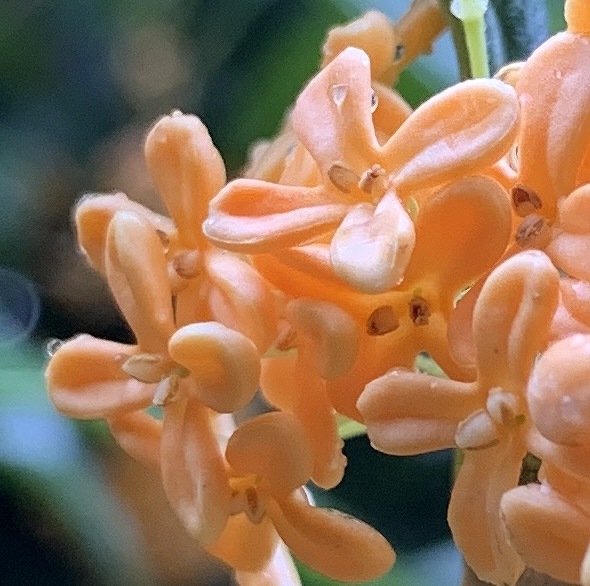キンモクセイは美しい橙黄色の花と甘く濃厚な芳香で人々を魅了。雌雄異株ですが日本で見られるのは挿し木で殖えた雄株(雄花)だけです。
Osmanthus fascinates people with its beautiful orange-yellow flowers and sweet, rich fragrance. Although it is dioecious, only male strains (male flowers) cultivated by cuttings can be seen in Japan.
【仮名】キンモクセイ, ガンケイ
【和名】金木犀, 巌桂
【英名】Osmanthus
【学名】Osmanthus fragrans aurantiacus
【誕生】10/ 07, 10/ 18, 11/ 25
【開花】09, 10月
【花色】Yellow, Orange



キンモクセイ
キンモクセイの分布
キンモクセイはギンモクセイの変種で、モクセイ科モクセイ属の常緑樹。原産地の中国ではギンモクセイとその変種が桂花茶の原料として大規模に栽培されています。日本には江戸時代に渡来し、北海道と沖縄県を除く各地に植栽。実生でなく、人の手による挿し木で増やされました。
キンモクセイの名前
キンモクセイの名前の由来は、樹皮がサイの足に似ている木なので「木犀」。そして、花が白色の「銀木犀」に対し、花が橙黄色だから「金木犀」です。受粉させて種子を取らなくても、挿し木で簡単に増殖可能。花が美しく、芳香を放つので、おもに庭木や街路樹として好まれます。
キンモクセイの花
キンモクセイは葉腋に小さく集まって着花。ギンモクセイよりも花数が多く見応えがあります。雌雄異株ですが、日本で見られるのは花つきの良い雄株だけ。雄花は2本の雄しべと不完全な雌しべがあります。中国で見られる雌花は、冬にクコのような小さな実を付け、熟すと紫色に。
キンモクセイの芳香
キンモクセイの芳香は強く、ギンモクセイより甘く濃厚。日本で便所が汲み取り式だった頃、悪臭をごまかすため便所の近くにキンモクセイが植えられました。その後、トイレの芳香剤にキンモクセイに似せた合成香料が採用。そのため、キンモクセイでトイレを連想する人もいます。
キンモクセイの薬用
キンモクセイの花には薬理作用があります。味覚神経を刺激して唾液や胃液の分泌を促進したり、血液循環にも役立つ成分を含有。そのため、乾燥させた花を煮出して「桂花茶」にしたり、白ワインに漬けて「桂花陳酒」にしたり、蜜煮で「桂花醤」という香味料に仕立てたりします。
キンモクセイの花言葉
キンモクセイの花の美しい橙黄色、甘く濃厚な芳香から、花言葉は「誘惑」「陶酔」。その一方で、花それ自体は小さな集まりであることから「謙虚」「真実」「気高い人」という花言葉もあります。中国での呼称は「桂花」のほか、「丹桂」「金桂」とも。美しく香る東洋の花です。
Osmanthus
Osmanthus is a variety of ginmokusei, an evergreen tree of the genus Oleaceae of the family Oleaceae. In China, the place of origin, Osmanthus fragrans and its varieties are cultivated on a large scale as a raw material for Keika tea. It came to Japan during the Edo period and was planted in various places except Hokkaido and Okinawa prefectures. It was increased by cuttings by human hands, not by seedlings.
The origin of the name of Osmanthus is “Mokusei” because the bark is a tree that resembles the legs of a rhinoceros. And, while the flowers are white “Ginmokusei”, the flowers are orange-yellow, so it is “Kinmokusei”. It can be easily propagated with cuttings without pollinating and removing seeds. The flowers are beautiful and fragrant, so they are mainly preferred as garden trees and roadside trees.
Osmanthus gather in small axils and set flowers. It has more flowers than Ginmokusei and is spectacular. It is dioecious, but only male strains with good flowers can be seen in Japan. Male flowers have two stamens and an incomplete pistil. Female flowers found in China bear wolfberry-like small fruits in winter and turn purple when ripe.
The fragrance of Osmanthus is strong, sweeter and richer than that of Ginmokusei. When the toilet was a pumping up in Japan, Fragrant olive was planted near the toilet to disguise the stink. After that, a synthetic fragrance similar to Fragrant olive was adopted as a toilet fragrance. Therefore, some people associate Fragrant olive with a toilet.
Osmanthus flowers have a pharmacological effect. Contains ingredients that stimulate the taste nerves to promote the secretion of saliva and gastric fluid, and are also useful for blood circulation. Therefore, dried flowers are boiled to make “Keikacha”, soaked in white wine to make “Keika Chenshu”, or boiled in honey to make a flavoring called “Keikasho”.
By the beautiful orange-yellow color of the Osmanthus flower and the sweet and rich fragrance, the flower language is “temptation” and “euphoria”. On the other hand, since the flowers themselves are small groups, there are also flower words such as “modesty,” “truth,” and “noble person.” In addition to “Keika”, the names in China are also “Tankei” and “Kinkei”. It is a beautifully scented oriental flower.


